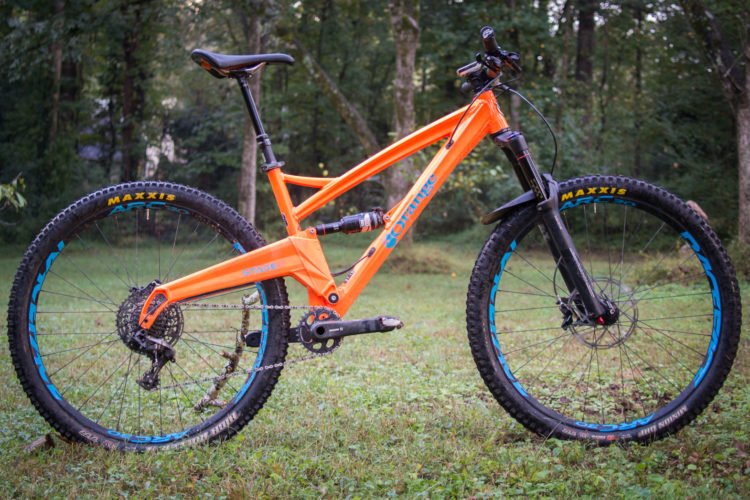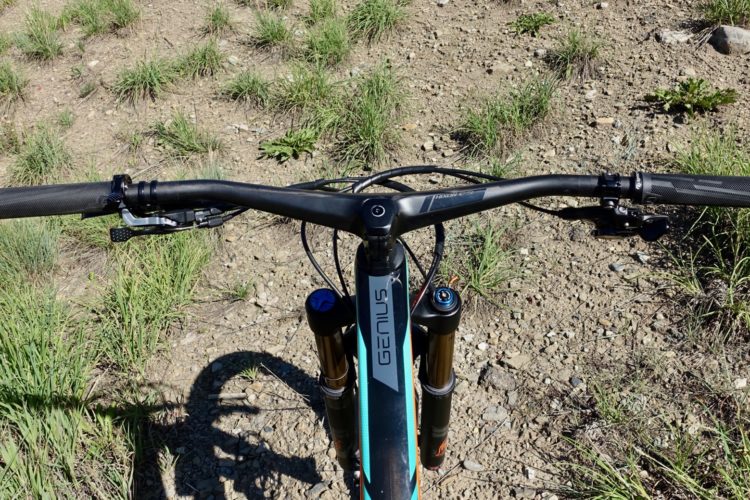
In case you missed it last week, Trek updated their popular trail bike, the Fuel EX. Naturally the bike is longer and slacker, but there are a few subtle changes to note as well. We got a chance to check out the bike in person at Crankworx last week, and after diving into the stats a bit more, here are some key takeaways.
Adjustable geometry gets tweaked
Editor’s note: The analysis in this section was based on incorrect information published on the Trek website on August 21, 2019. In fact, the bottom bracket height does change between high and low modes.
Trek’s adjustable geometry feature, dubbed Mino Link, offers the ability to set the bike in “high” or “low” mode. It’s interesting to note that in the updated Trek Fuel EX, both high and low modes promise a consistent bottom bracket (BB) height; only the bottom bracket drop is changed. In previous versions of the Fuel EX, both the BB drop and the height were affected by the Mino Link position.

The upshot to this change is a consistent height which should mean fewer accidental pedal strikes when swapping between modes. In low mode, riders keep the same bottom bracket height and pedal clearance as high mode. It’s unclear how this is actually accomplished, though one clue may be that the placement of the Mino Link chip appears to have moved inboard rather than outboard as in previous models.
Wheelbase and reach get longer

The wheelbase on the new Fuel EX grew about 20mm (size large) to 121cm. Much of this added length comes from the reach (up to 47.5cm in large) but a bit comes from the longer chainstays as well (up to 43.7cm).
It’s slacker
If there is any doubt about whether bikes will continue to get much slacker, this update shows angle changes are still making significant jumps. The Fuel EX sports a 66-degree head tube angle (66.5 degrees in low mode), one degree slacker than the previous version.

To compensate for the more relaxed head tube angle, Trek, like others, steepened the seat tube angle to 75 degrees (75.5 degrees in low mode), again moving the needle by a degree. It’s worth noting that going from low to high mode slackens both the head tube angle and the effective seat tube angle (this is the opposite direction from previous versions, which makes the terms high and low confusing). Not only is this confusing, it also seems counterproductive since a steeper seat tube angle is generally used to move weight forward for climbing to compensate for a more slack head tube angle.
To account for the slackened head tube angle on the new Fuel EX, Trek decreased the fork offset from 51mm to 43mm.
More sizes
Select models of the 2020 Trek Fuel EX are offered in sizes ranging from XS all the way up to XXL. Previously, the Fuel EX was only specced with 29er wheels which precluded offering an XS frame.
For 2020, Trek is speccing extra small and small size frames with 27.5″ wheels, while the rest of the line of sizes use 29er wheels. Riders who fit a size small are in luck with options, as Trek offers small bikes with either 29er or 27.5″ wheels.
Internal frame storage
Perhaps one of the most notable features of the new Fuel EX is the addition of internal frame storage. Of course there’s another big bike company that’s been offering a similar feature for a few years now, but that doesn’t take anything away from the utility of being able to stash tools and supplies on the bike. Trek’s solution features a large, easy to use lever to secure the trap door to the frame. In my experience, it’s a bit more intuitive to use than the other internal frame storage solution on the market.

More travel in front
The Fuel EX still offers 130mm of rear travel, but Trek upped front suspension travel to 140mm. Even with the slightly bigger fork, Trek claims the weight of a medium Fuel EX 9.9 dropped slightly from 26.87 to 26.45 pounds.
MSRP changes

Most Fuel EX models are seeing a slight bump in the suggested retail pricing. The Fuel EX 7 is about $70 more expensive than last year’s model at $2,900. Both the EX 9.7 and 9.8 models tack on an extra $100 over last year’s prices at $4,100 and $5,500, respectively.
Only the Fuel EX 9.9 model sees a price reduction, dropping from about $7800 down to $7500.
Overall, the Trek Fuel EX appears to be an even more capable descender than ever before with minimal compromise in its climbing abilities.





















